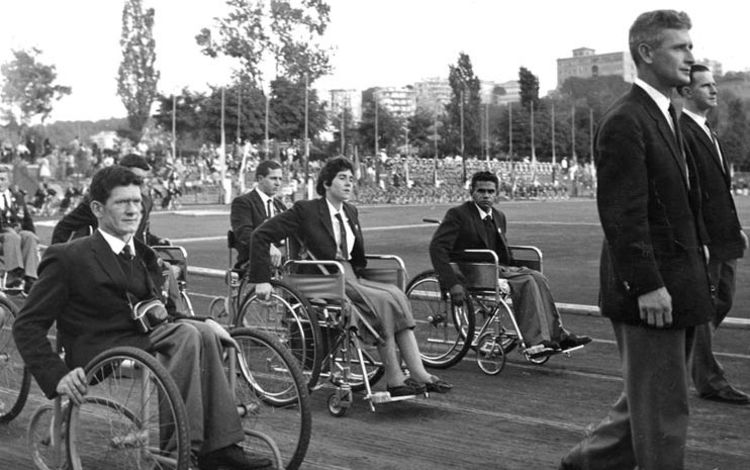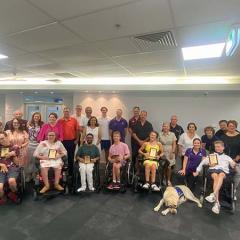The history of the Australian Paralympic movement is being preserved for future generations, thanks to the tireless efforts of UQ researchers and an army of volunteers.

The project, titled ‘Creating Histories of the Australian Paralympic Movement: A New Relationship between Researchers and the Community’, has three major components: Wikipedia pages, a website, and a book (which is at manuscript stage).
The website, Paralympic Stories, was launched in April 2019, and is a major milestone for the project.
It features images, film, audio interviews, ephemera and memorabilia from Paralympic Summer and Winter Games and a range of other events that cover the history of the Paralympic movement in Australia.
The materials on the website come from a wide range of sources to chronicle the development of the disability sport movement in Australia from the early years of the 20th century, through the establishment of wheelchair sport at rehabilitation centres after World War II, the first team to leave Australian shores in 1957, the first Paralympic Games in 1960, and the incredible progress in the decades since.
It is structured so that visitors can explore specific events, sports, years or individuals, or choose their own journey.
The project was awarded funding under the prestigious Australian Research Council Linkage Projects scheme in 2014, and is a collaboration between UQ’s School of Human Movement and Nutrition Sciences, through Professor Murray Phillips and Associate Professor Gary Osmond, and Paralympics Australia, through Tony Naar.
Combining the expertise and knowledge of UQ and Paralympics Australia with Wikimedia Australia, the project has created a new relationship between historical research, disability sport and the Australian community, while exploring and analysing the historical development of sport for people with disabilities in Australia.
Working with Wikimedia Australia editors has resulted in the creation of almost 1000 Wikipedia articles about Australian Paralympic sport, which provide a huge knowledge base for the project and are collectively viewed 120,000 times every month.
“Wikimedia Australia, with its volunteer community, global reach and incredible popularity, has been a perfect vehicle to help create and tell the story of the Australian Paralympic movement,” Professor Phillips said.
“We were faced with the challenge of researching the history of this movement in all of its cultural, social, technical and political complexities, and exploring its potent symbolism.
“Paralympic Stories is the culmination of thousands of hours of work, much of it done by volunteers. Literally hundreds of people have worked on this project, and we are grateful for national memory institutions the National Library of Australia, the National Film and Sound Archive, the Clearinghouse for Sport and the National Sports Museum for their support.”
The project raises the profile not only of the Paralympic Games but also of other important but lesser-known events like the Far East and South Pacific Games for the Disabled (FESPIC), a multi-sports games in Asia and the South Pacific region that was held nine times between 1975 and 2006, and the Commonwealth Paraplegic Games, held four times between 1962 and 1974.
Dr Osmond said the project has had some unexpected overlap with the research team’s interest in Australian Indigenous sport history.
“There have been a number of surprising and delightful outcomes. For example, I currently have an ARC Future Fellowship titled ‘Sport, Stories and Survival: Reframing Indigenous Sport History’, where I am working with several Indigenous communities in Queensland. One of these is Thursday Island in the Torres Strait.
Through that involvement, I discovered that a Paralympian who’d been thought to be from Western Australia was actually from the Torres Strait. This was news to Paralympics Australia,” Dr Osmond said.
“The athlete, Harry Mosby, is Australia’s first and only Torres Strait Islander Paralympian. At the 1976 Toronto Games, he won a silver medal in the men's discus and finished fourth in the men's javelin, fifth in the men's shot put and twelfth in the men's precision javelin.
“Project team members also discovered that Paralympic athlete Ray Barrett was an Indigenous Australian. He was a bronze medallist at the 1972 Summer Paralympics in Heidelberg.
“Adding Ray and Harry extended the list of known Indigenous Paralympians from 11 to 13, and also dovetailed with our new ARC Discovery project titled ‘Pride, Resilience and Identity: Reimagining Aboriginal Sport History’.”
Both researchers agree that it has been a monumental effort to capture, manage, preserve and share the history of the Paralympic movement in Australia.
Professor Phillips stresses the relevance of placing the Paralympic movement within its broader social context.
“The significance of the Paralympic movement in terms of its power to change public perceptions and attitudes towards disability, to influence public policy and to empower people with a disability as full participants in society cannot be underestimated.”
Anyone with a story or item related to the Paralympic movement in Australia is invited to contribute via the website.



